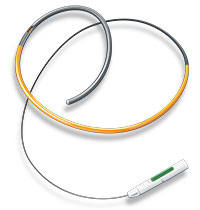Physiological measurements such as fractional flow reserve (FFR) and resting full-cycle ratio (RFR) can be used to evaluate the functional significance of coronary stenosis.1,2
Beyond the visibility of angiography, index of microcirculatory resistance (IMR) and coronary flow reserve (CFR) can be used to diagnose coronary microvascular dysfunction (CMD).3,4
A full physiology assessment can help determine an accurate diagnosis to improve patient outcomes and enhance quality of life.3-6
The innovative PressureWire™ X Guidewire—the world’s only1,7 full physiology wire can measure pressure and temperature to calculate Abbott's RFR, FFR, IMR, and CFR. The guidewire’s fully integrated, secure, wireless measurements are integral to a cardiac cath lab’s clinical physiology routine.1

The CoroFlow‡ Cardiovascular System is an advanced platform to measure physiological indices: FFR and RFR to assess epicardial vessels; plus CFR and IMR to assess microcirculation. This system is designed specifically to communicate with the wireless PressureWire™ X Guidewire.1,8

The OPTIS™ Next Imaging Systems offer wireless physiology (FFR and RFR) and optical coherence tomography (OCT) with seamless integration into the cath lab and PCI workflow.9

Ultreon™ Software is the next-generation imaging and physiology software. Streamlined and intuitive, Ultreon™ Software gives better insights to optimize patient outcomes through automation and improved workflow.10-13



MAT-2104372 v3.0
You are about to enter an Abbott country- or region-specific website.
Please be aware that the website you have requested is intended for the residents of a particular country or countries, as noted on that site. As a result, the site may contain information on pharmaceuticals, medical devices and other products or uses of those products that are not approved in other countries or regions
Do you wish to continue and enter this website?
MAT-2305078 v1.0